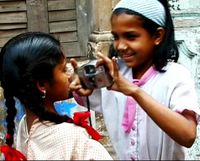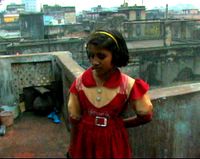Review: "Born into Brothels"
 Yesterday I saw "Born into Brothels," Best Documentary at the Oscars this year. American Zana Briski and collaborator Ross Kauffman, intending to make a movie about prostitution in Calcutta's Sonagachi red light district, did manage to get some furtive shots of weary, angry women on the line and men sauntering by. But everything in this world is illegal and sex workers understandably tried to avoid cameras.
Yesterday I saw "Born into Brothels," Best Documentary at the Oscars this year. American Zana Briski and collaborator Ross Kauffman, intending to make a movie about prostitution in Calcutta's Sonagachi red light district, did manage to get some furtive shots of weary, angry women on the line and men sauntering by. But everything in this world is illegal and sex workers understandably tried to avoid cameras. Unexpectedly, the children born to these women and men, raised haphazardly in these brothels, came tumbling out of alleyways to adopt Briski and take over her project.
Unexpectedly, the children born to these women and men, raised haphazardly in these brothels, came tumbling out of alleyways to adopt Briski and take over her project. From kids with cameras.org (a site where you can purchase some of the kids' pictures):
From kids with cameras.org (a site where you can purchase some of the kids' pictures):In Calcutta's red light district, over 7,000 women and girls work as prostitutes. Only one group has a lower standing: their children. Zana Briski became involved in the lives of these children in 1998.Living in the brothels for months at a time, she developed a relationship with many of the kids who, often terrorized and abused, were drawn to the rare human companionship she offered ... Zana thought it would be great to see the world through their eyes. It was at that moment that she had the idea of teaching photography to the children of prostitutes.
Zana held weekly photography workshops between 2000 and 2003. There the children learned camera basics, lighting, composition, the development of point-of-view, editing, and sequencing for narrative. To Zana's delight, equipped with inexpensive point-and-shoot 35mm cameras, the children produced incredible work. Their images are explosions of color: self-portraits, family pictures, street scenes, stunning tableaus of Bengali life.
 Briski challenged the kids to get the pictures she never could; in response they blossomed, bouncing out into the streets with their cameras and bringing their world back to the darkroom. They heatedly discuss the contact sheets, squinting at them like pros, marking favorites with crayons.
Briski challenged the kids to get the pictures she never could; in response they blossomed, bouncing out into the streets with their cameras and bringing their world back to the darkroom. They heatedly discuss the contact sheets, squinting at them like pros, marking favorites with crayons. This optimistic story is balanced by forces that pull them back towards darkness, just as joyous excursions to the zoo and the ocean are followed by weary trudges back into squalid courtyards. How wearily the kids accept their reality: they are sworn at and beaten; they wash pots in dark stairwells; they feel doomed.
This optimistic story is balanced by forces that pull them back towards darkness, just as joyous excursions to the zoo and the ocean are followed by weary trudges back into squalid courtyards. How wearily the kids accept their reality: they are sworn at and beaten; they wash pots in dark stairwells; they feel doomed.My father tried to sell me - if my sister didn't come to get me ...
I'm worried I'll become like them.
She'll end up on the street - she'll do drugs and snatch peoples' money.
Talking about his father, now addicted to hash, a boy says proudly but sadly: In the past my father was a very good man.
Her great-grandmother is a prostitute, her grandmother is a prostitute, her mother is a prostitute, and she will be one too.People here live in chaos. Nobody lives as filthily. Wherever there are dirty plates, we find shoes right next to them.
Briski, an earnest woman, stops observing and becomes a player after one student is married off at 11 and another is put "on the line" at 14. She feels compelled to get her young photographers out of the brothels. So begins an arduous journey through antiquated bureaucracies - each tiny step requires scores of stamped applications, and few schools will take children of sex workers - and a series of exhibitions in international photo galleries to raise money for the schooling.
 Time runs short. One boy loses heart after his mother is burned to death by her pimp in her kitchen. The girls, growing up before our eyes, are increasingly pressured to contribute to family income by joining the line.
Time runs short. One boy loses heart after his mother is burned to death by her pimp in her kitchen. The girls, growing up before our eyes, are increasingly pressured to contribute to family income by joining the line.Briski works frantically to get the kids into boarding schools and is eventually successful. An honest epilogue, though, reveals that while some of the kids do stay in school, others run away, some are taken away by their mothers, and the ripest of them was never allowed to leave the brothel at all.
 The movie's luscious cinematography sates the eye with gorgeous, grainy, smudged images shot hurriedly in dark alleys; flashes of cerulean and emerald gleaming out of stygian stairwells (if it didn't sound so pompous I'd use the word chiaroscuro); intensely saturated colors, vibrant in juxtaposed scenes of sunlight and shadow; jewel-like silks - even men wear saffron and turquoise - richly illuminating gritty, rough surroundings. Ambient light pools in children's huge, liquid, wistful dark eyes.
The movie's luscious cinematography sates the eye with gorgeous, grainy, smudged images shot hurriedly in dark alleys; flashes of cerulean and emerald gleaming out of stygian stairwells (if it didn't sound so pompous I'd use the word chiaroscuro); intensely saturated colors, vibrant in juxtaposed scenes of sunlight and shadow; jewel-like silks - even men wear saffron and turquoise - richly illuminating gritty, rough surroundings. Ambient light pools in children's huge, liquid, wistful dark eyes. Through the film Briski advises the kids: fill each frame with information, with layers of images, with "environment, details, shutters, wires hanging, angles" - she practices what she preaches.
Through the film Briski advises the kids: fill each frame with information, with layers of images, with "environment, details, shutters, wires hanging, angles" - she practices what she preaches. Particularly breathtaking are moments when kids climb out of claustrophobic courtyards to dance on the rooftops, flying their kites and watch birds soar.
Particularly breathtaking are moments when kids climb out of claustrophobic courtyards to dance on the rooftops, flying their kites and watch birds soar. Maybe my takeaway thought is that children everywhere can have magnificent spirits and minds; they should never be underestimated, and they must be given a chance.
Maybe my takeaway thought is that children everywhere can have magnificent spirits and minds; they should never be underestimated, and they must be given a chance.p.s. - Wonderful music - I would even buy the soundtrack -
Technorati Tags: Review, Brothels, India, Movie



 A few of my daughter
Melina's great posts:
A few of my daughter
Melina's great posts:








6 Comments:
I have wanted to see this since I saw it on the Oscars. Hope it comes out on DVD soon.
It IS on DVD! I got it from NetFlix! That's how I was able to make these screenshots!
Thank you for a wonderful post. I'd never heard of the movie, but now I want to see it.
Oh,and you and I posted at the same moment over at Michele's so I missed your name, but I came to visit you anyway. Glad I did :-)
Michele sent me! I have never seen this film but what a wonderful description you give here. It seems very powerful
I've been meaning to see this documentary for quite some time now. After reading this, I definately will make more of an effort to do so.
Michele sent me.
hi, here via michele. thanks for letting me know about this film. will definitely look for the dvd. :)
Post a Comment
<< Home